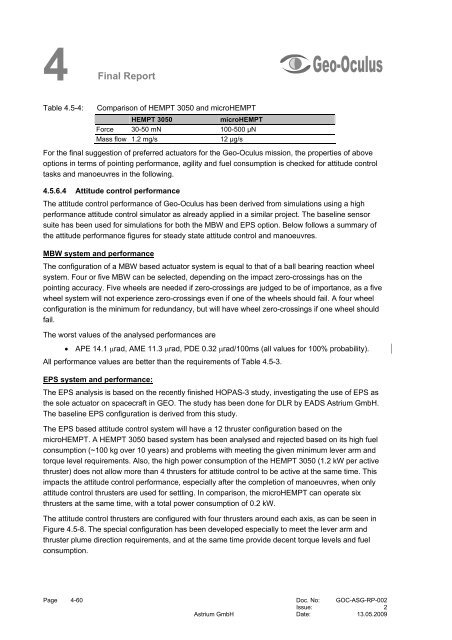4 Final Report - Emits - ESA
4 Final Report - Emits - ESA
4 Final Report - Emits - ESA
Create successful ePaper yourself
Turn your PDF publications into a flip-book with our unique Google optimized e-Paper software.
4 <strong>Final</strong><br />
<strong>Report</strong><br />
Table 4.5-4: Comparison of HEMPT 3050 and microHEMPT<br />
HEMPT 3050 microHEMPT<br />
Force 30-50 mN 100-500 µN<br />
Mass flow 1.2 mg/s 12 µg/s<br />
For the final suggestion of preferred actuators for the Geo-Oculus mission, the properties of above<br />
options in terms of pointing performance, agility and fuel consumption is checked for attitude control<br />
tasks and manoeuvres in the following.<br />
4.5.6.4 Attitude control performance<br />
The attitude control performance of Geo-Oculus has been derived from simulations using a high<br />
performance attitude control simulator as already applied in a similar project. The baseline sensor<br />
suite has been used for simulations for both the MBW and EPS option. Below follows a summary of<br />
the attitude performance figures for steady state attitude control and manoeuvres.<br />
MBW system and performance<br />
The configuration of a MBW based actuator system is equal to that of a ball bearing reaction wheel<br />
system. Four or five MBW can be selected, depending on the impact zero-crossings has on the<br />
pointing accuracy. Five wheels are needed if zero-crossings are judged to be of importance, as a five<br />
wheel system will not experience zero-crossings even if one of the wheels should fail. A four wheel<br />
configuration is the minimum for redundancy, but will have wheel zero-crossings if one wheel should<br />
fail.<br />
The worst values of the analysed performances are<br />
• APE 14.1 μrad, AME 11.3 μrad, PDE 0.32 μrad/100ms (all values for 100% probability).<br />
All performance values are better than the requirements of Table 4.5-3.<br />
EPS system and performance:<br />
The EPS analysis is based on the recently finished HOPAS-3 study, investigating the use of EPS as<br />
the sole actuator on spacecraft in GEO. The study has been done for DLR by EADS Astrium GmbH.<br />
The baseline EPS configuration is derived from this study.<br />
The EPS based attitude control system will have a 12 thruster configuration based on the<br />
microHEMPT. A HEMPT 3050 based system has been analysed and rejected based on its high fuel<br />
consumption (~100 kg over 10 years) and problems with meeting the given minimum lever arm and<br />
torque level requirements. Also, the high power consumption of the HEMPT 3050 (1.2 kW per active<br />
thruster) does not allow more than 4 thrusters for attitude control to be active at the same time. This<br />
impacts the attitude control performance, especially after the completion of manoeuvres, when only<br />
attitude control thrusters are used for settling. In comparison, the microHEMPT can operate six<br />
thrusters at the same time, with a total power consumption of 0.2 kW.<br />
The attitude control thrusters are configured with four thrusters around each axis, as can be seen in<br />
Figure 4.5-8. The special configuration has been developed especially to meet the lever arm and<br />
thruster plume direction requirements, and at the same time provide decent torque levels and fuel<br />
consumption.<br />
Page 4-60 Doc. No: GOC-ASG-RP-002<br />
Issue: 2<br />
Astrium GmbH Date: 13.05.2009

















